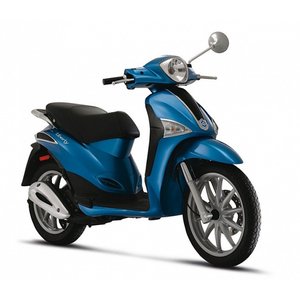Piaggio Liberty 50 4T (2000–2003): A Timeless Urban Companion
Introduction
The Piaggio Liberty 50 4T, produced between 2000 and 2003, is a scooter that embodies practicality and simplicity. Designed for urban commuters, this model generation strikes a balance between classic Italian styling and no-nonsense functionality. Even decades after its release, the Liberty 50 4T remains a common sight in European cities, a testament to its reliability and enduring appeal. But how does it hold up from a rider’s perspective today? Let’s dive into the details.
Design and Build Quality
The Liberty 50 4T’s design is quintessentially Piaggio: clean, rounded lines and a minimalist aesthetic that avoids excessive frills. The bodywork is predominantly plastic, but it feels robust enough to withstand daily urban abuse. At 105 kg (231 lbs), it’s lightweight enough for effortless maneuvering through traffic or pushing into tight parking spots. The 780 mm (30.7-inch) seat height ensures accessibility for riders of all statures, while the flat floorboard adds practicality for carrying small bags or groceries.
The scooter’s under-seat storage is modest but functional, fitting a half-face helmet or a compact backpack. The analog instrument cluster is straightforward, with a speedometer, fuel gauge, and basic warning lights—no distractions, just the essentials. Paint quality on older models can show wear, but the overall build feels solid for its class.
Engine and Performance
Powered by a 49 cc air-cooled, four-stroke single-cylinder engine, the Liberty 50 4T delivers 3.8 PS (2.8 kW) of power. While these numbers won’t set any speed records, the engine’s focus is on efficiency and reliability. Top speed is limited to around 45 km/h (28 mph), making it ideal for city zones with strict speed limits. Acceleration is leisurely—0 to 40 km/h (0–25 mph) takes its time—but the engine’s smooth power delivery and frugal fuel consumption (roughly 40–50 km/L or 94–118 mpg) are where it shines.
The four-stroke design avoids the smokey exhaust and frequent maintenance quirks of older two-stroke rivals. Cold starts are reliable, though the carbureted engine occasionally demands a gentle throttle hand during warm-up. At idle, the engine hums at 1,950 ± 50 RPM, emitting a subdued, almost meditative purr.
Ride and Handling
The Liberty 50 4T’s ride quality is where it truly excels in urban environments. The suspension setup—basic telescopic forks up front and dual shock absorbers at the rear—is tuned for comfort over potholes and cobblestones. It’s no canyon carver, but the scooter feels planted and stable at city speeds. The narrow tires (likely 90/90-10 front and rear) offer quick steering reflexes, perfect for darting through traffic or navigating crowded streets.
Braking is handled by a single drum brake at both ends. While lacking the bite of modern disc systems, the brakes provide adequate stopping power for the scooter’s modest performance. Tire pressure recommendations (1.8 bar/26 psi front, 2.0 bar/29 psi rear) should be adhered to for optimal grip and longevity.
Competition
In the 50 cc scooter segment, the Liberty 50 4T faced stiff competition from rivals like the Honda Today 50, Yamaha Vity 50, and Peugeot Speedfight 50. Here’s how it stacks up:
- Honda Today 50: Honda’s offering prioritized featherweight agility (under 90 kg/198 lbs) and a slightly peppier two-stroke engine. However, the Today’s smaller frame felt cramped for taller riders, and its two-stroke required more frequent oil refills.
- Yamaha Vity 50: Yamaha’s four-stroke Vity matched the Liberty’s reliability but added a sportier design. The Vity’s suspension was stiffer, trading comfort for sharper handling—a divisive choice for city riders.
- Peugeot Speedfight 50: A favorite among modders, the Speedfight’s two-stroke engine delivered more punch but demanded meticulous maintenance. Its aggressive styling also appealed to younger riders.
The Liberty 50 4T carved its niche with a balanced ride, approachable ergonomics, and Piaggio’s reputation for durability. While it lacked the Speedfight’s youth appeal or the Today’s hyper-efficiency, it remains a well-rounded choice for practicality-focused riders.
Maintenance
Owning a Liberty 50 4T is refreshingly straightforward, but attention to a few key areas will ensure longevity:
Engine Care
- Valve Adjustments: The engine requires periodic valve clearance checks—0.10 mm (0.004 in) for intake and 0.15 mm (0.006 in) for exhaust valves when cold. Neglecting this can lead to noisy operation and reduced performance.
- Oil Changes: Use SAE 5W-40 oil (850 ml/28.7 oz with filter changes). Regular intervals are critical for the air-cooled engine’s health.
Electrics and Ignition
- Spark Plugs: Pre-2005 models use NGK CR9EB, while later variants require NGK PMR7A. Gap electrodes to 0.8 mm (0.031 in) or 0.7 mm (0.028 in) depending on the year.
- Battery: Keep terminals clean; the charging system is reliable but struggles with aftermarket accessories.
Brakes and Fluids
- Brake Fluid: DOT 4 fluid ensures consistent braking performance. Replace every two years to prevent moisture buildup.
- Final Drive Oil: The 85 ml (2.9 oz) of SAE 80W-90 gear oil in the rear hub should be refreshed annually.
Tires and Suspension
- Tire Pressure: Underinflated tires worsen handling and fuel economy. Stick to Piaggio’s recommendations.
- Fork Oil: SAE 20W oil in the forks maintains plushness over bumps. Consider upgrading to synthetic oils for smoother performance.
MOTOPARTS.store Recommendations:
- Upgrade to high-grip tires like the Michelin City Pro for wet weather confidence.
- Swap stock spark plugs for iridium variants (e.g., NGK CR9EIX) for better combustion efficiency.
- Install a reinforced drive belt to reduce wear during stop-and-go riding.
Conclusion
The Piaggio Liberty 50 4T (2000–2003) is a scooter that prioritizes function over flair—and that’s precisely its charm. It won’t thrill adrenaline seekers, but as a daily workhorse, it’s hard to fault. The lightweight frame, forgiving ride, and bulletproof mechanics make it ideal for first-time riders or seasoned commuters seeking hassle-free transportation. While newer scooters offer flashier tech, the Liberty’s simplicity ensures it ages gracefully. For owners looking to refresh their trusty steed, MOTOPARTS.store offers everything from OEM-spec components to performance upgrades, ensuring your Liberty stays road-ready for years to come.



















